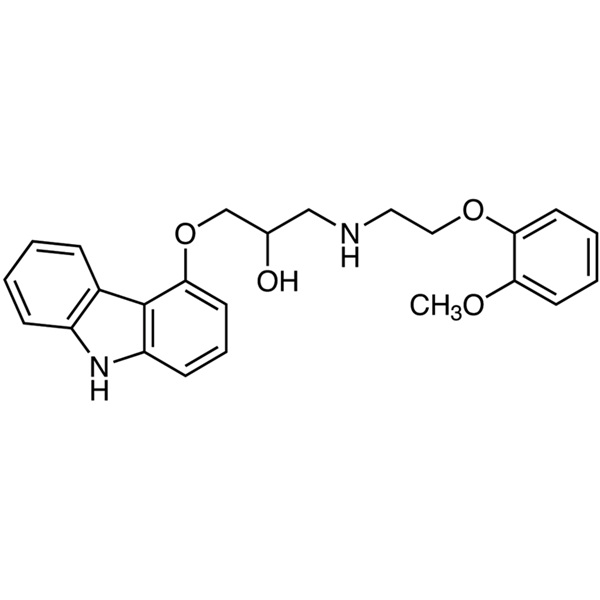Carvedilol CAS 72956-09-3 Purity >99.0% (HPLC)
Shanghai Ruifu Chemical Co., Ltd. is the leading manufacturer of Carvedilol (CAS: 72956-09-3) with high quality. Ruifu Chemical can provide worldwide delivery, competitive price, excellent service, small and bulk quantities available. Purchase Carvedilol, Please contact: alvin@ruifuchem.com
| Chemical Name | Carvedilol |
| Synonyms | 1-(9H-Carbazol-4-yloxy)-3-[[2-(2-Methoxyphenoxy)ethyl]amino]-2-Propanol; Artist; Cadilan; Carca; Cardivas; Carloc; Carvas; Carvedilol; Carvediol; Coreg; DQ 2466; Dilatrend; Dimitone; Eucardic; Korvasan; Kredex; Querto; Talliton; BM-14190 |
| Stock Status | In Stock, GMP Commercial |
| CAS Number | 72956-09-3 |
| Molecular Formula | C24H26N2O4 |
| Molecular Weight | 406.48 g/mol |
| Melting Point | 115.0 to 119.0℃ |
| Density | 1.250±0.06 g/cm3 |
| Solubility in Water | Insoluble in Water |
| Solubility | Soluble in Methanol. Slightly Soluble in Ethanol, Ether |
| Storage Temp. | Cool & Dry Place (2~8℃) |
| COA & MSDS | Available |
| Brand | Ruifu Chemical |
| Items | Inspection Standards | Results |
| Appearance | White Crystalline Powder | Complies |
| Loss on Drying | ≤0.50% (105℃ for 3 h) | 0.25% |
| Residue on Ignition | ≤0.10% | 0.07% |
| Related Substances | ||
| Total Impurities | ≤0.50% | Complies |
| Impurity A | ≤0.20% | Complies |
| Impurity C | ≤0.02% | Complies |
| Any Other Individual Impurity | ≤0.10% | Complies |
| Heavy Metals (Pb) | ≤10ppm | <10ppm |
| Purity / Analysis Method | >99.0% (HPLC) | 99.72% |
| Infrared Spectrum | Conforms to Structure | Complies |
| Conclusion | The product has been tested & complies with the specifications | |
Package: Bottle, Aluminium foil bag, 25kg/Cardboard Drum, or according to customer's requirement.
Storage Condition: Store in a tightly closed container. Store in a cool, dry (2~8℃) and well-ventilated warehouse away from incompatible substances. Protect from light and moisture.
Shipping: Deliver to worldwide by air, by FedEx / DHL Express. Provide fast and reliable delivery.
How to Purchase? Please contact Dr. Alvin Huang: sales@ruifuchem.com or alvin@ruifuchem.com
15 Years Experience? We have more than 15 years of experience in the manufacture and export of a wide range of high quality pharmaceutical intermediates or fine chemicals.
Main Markets? Sell to domestic market, North America, Europe, India, Korea, Japanese, Australia, etc.
Advantages? Superior quality, affordable price, professional services and technical support, fast delivery.
Quality Assurance? Strict quality control system. Professional equipment for analysis include NMR, LC-MS, GC, HPLC, ICP-MS, UV, IR, OR, K.F, ROI, LOD, MP, Clarity, Solubility, Microbial limit test, etc.
Samples? Most products provide free samples for quality evaluation, shipping cost should be paid by customers.
Factory Audit? Factory audit welcome. Please make an appointment in advance.
MOQ? No MOQ. Small order is acceptable.
Delivery Time? If within stock, three days delivery guaranteed.
Transportation? By Express (FedEx, DHL), by Air, by Sea.
Documents? After sales service: COA, MOA, ROS, MSDS, etc. can be provided.
Custom Synthesis? Can provide custom synthesis services to best fit your research needs.
Payment Terms? Proforma invoice will be sent first after confirmation of order, enclosed our bank information. Payment by T/T (Telex Transfer), PayPal, Western Union, etc.
Hazard Codes N,Xn
Risk Statements 51/53-36/37/38-20/21/22
Safety Statements 61-36-26
RIDADR UN 3077 9/PG 3
WGK Germany 3
RTECS UA8670000
HazardClass IRRITANT
PackingGroup III
Hazardous Substances Data 72956-09-3(Hazardous Substances Data)
Toxicity LD50 oral in dog: > 1gm/kg
Carvedilol (CAS: 72956-09-3) is a vasodilating beta-blocker useful in the treatment of hypertension and angina pectoris. In addition to lowering blood pressure, carvedilol decreases total vascular resistance without the reflex tachycardia usually occurring with vasodilators. It is reported to be well tolerated with renal sparing effects.
Carvedilol was first launched in Belgium in 1985. This product can block alpha and beta receptors, no intrinsic activity, in high concentrations of fashion with calcium antagonism. It has a strong effect of blocking beta receptors, which can expand blood vessels, reduce peripheral resistance and lower blood pressure, and has little effect on cardiac output and heart rate. Clinical can be used for primary hypertension and angina pectoris.
| rU= | peak response of carvedilol from the Sample solution |
| rS= | peak response of carvedilol from the Standard solution |
| CS= | concentration of carvedilol in the Standard solution (mg/mL) |
| CU= | concentration of Carvedilol in the Sample solution (mg/mL) |
| rU | = | peak response of the corresponding related compound or any other impurity from the Sample solution |
| rS | = | peak response of the corresponding related compound from the Standard solution. To calculate the percentage of any other individual impurity use the peak response of carvedilol. |
| CS | = | concentration of the corresponding related compound in the Standard solution (mg/mL). To calculate the percentage of any other impurities for CS, use the concentration of USP Carvedilol RS. |
| CU | = | concentration of Carvedilol in the Sample solution (mg/mL) |
| Name | Relative Retention Time | Acceptance Criteria, NMT (%) | |
| Carvedilol related compound Ea | 0.35 | 0.1 | |
| Carvedilol related compound Ab | 0.52 | 0.1 | |
| Carvedilol bisalkylpyrocatechol derivative (if present)c | 0.70 | 0.15 | |
| Carvedilol | 1.0 | — | |
| Carvedilol related compound Cd | 3.6 | 0.02 | |
| Carvedilol related compound De | 5.0 | 0.1 | |
| Carvedilol related compound Bf | 8.5 | 0.1 | |
| Any other individual impurity | - | 0.10 | |
| Total impurities | - | 0.5g | |
|
a 2-(2-Methoxyphenoxy)ethyl amine.
b 1-(4-(2-Hydroxy-3-(2-(2-methoxyphenoxy)ethylamino)propoxy)-9H-carbazol-9-yl)-3-(2-(2-methoxyphenoxy)ethylamino) propan-2-ol.
c 3,3¢-{2,2¢-[1,2-Phenylenebis(oxy)]bis(ethane-2,1-diyl)}bis(azanediyl)bis(1-(9H-carbazol-4-yloxy)propan-2-ol).
d 1-(9H-Carbazol-4-yloxy)-3-(benzyl(2-(2-methoxyphenoxy)ethyl)amino)propan-2-ol.
e 4-(Oxiran-2-ylmethoxy)-9H-carbazole.
f 3,3¢-(2-(2-Methoxyphenoxy)ethylazanediyl)bis(1-(9H-carbazol-4-yloxy)propan-2-ol).
g Disregard any impurity less than 0.01%.
|
|||
| Time (min) |
Solution A (%) |
Solution B (%) |
|---|---|---|
| 0 | 22 | 78 |
| 20 | 22 | 78 |
| 33 | 38 | 62 |
| 45 | 38 | 62 |
| 55 | 55 | 45 |
| 65 | 55 | 45 |
| 68 | 22 | 78 |
| 80 | 22 | 78 |
| rU | = | peak response for each impurity in the Sample solution |
| rT | = | sum of all the peak responses in the Sample solution |
| Name | Relative Retention Time |
Acceptance Criteria, NMT (%) |
|
|---|---|---|---|
| Carvedilol related compound Aa | 0.7 | 0.1 | |
| Carvedilol | 1.0 | — | |
| Carvedilol related compound Fb | 1.2 | 0.1c | |
| N-Isopropylcarvedilold | 1.6 | 0.1 | |
| Carvedilol related compound Ce | 1.8 | 0.02 | |
| Carvedilol related compound Bf | 2.1 | 0.1 | |
| Biscarbazoleg | 3 | 0.1 | |
| Any other individual impurity | — | 0.1 | |
| Total impurities | — | 0.5 | |
|
a 1-(4-(2-Hydroxy-3-(2-(2-methoxyphenoxy)ethylamino)propoxy)-9Hcarbazol-9-yl)-3-(2-(2-methoxyphenoxy)ethylamino) propan-2-ol.
b 1-(2-(2-Methoxyphenoxy)ethylamino)-3-(6,7,8,9-tetrahydro-5H-carbazol-4-yloxy)propan-2-ol.
c This impurity is quantitated using the procedure under Organic Impurities, Procedure 3: Carvedilol Related Compound F.
d 1-(H-Carbazol-4-yloxy)-3-[[2-(2-methoxyphenoxy)ethyl]N-isopropylamino]-2-propanol.
e 1-(9H-Carbazol-4-yloxy)-3-(benzyl(2-(2-methoxyphenoxy)ethyl)amino)propan-2-ol.
f 3,3'-(2-(2-Methoxyphenoxy)ethylazanediyl)bis(1-(9H-carbazol-4-yloxy)propan-2-ol).
g 1,3-Bis-(9H-carbazol-4-yloxy)-2-propanol.
|
|||
| rU | = | peak response of carvedilol related compound F from the Sample solution |
| rT | = | sum of the peak responses of carvedilol and carvedilol related compound F from the Sample solution |
| F | = | relative response factor, 1.1 |
1-(4-(2-Hydroxy-3-(2-(2-methoxyphenoxy)ethylamino)propoxy)-9H-carbazol-9-yl)-3-(2-(2-methoxyphenoxy)ethylamino) propan-2-ol.
C36H43N3O7 629.74
3,3'-(2-(2-Methoxyphenoxy)ethylazanediyl)bis(1-(9H-carbazol-4-yloxy)propan-2-ol).
C39H39N3O6 645.74
1-(9H-Carbazol-4-yloxy)-3-(benzyl(2-(2-methoxyphenoxy)ethyl)amino)propan-2-ol.
C31H32N2O4 496.60
4-(Oxiran-2-ylmethoxy)-9H-carbazole.
C15H13NO2 239.27
2-(2-Methoxyphenoxy)ethyl amine.
C9H13NO2 167.21
Mixture of approximately 0.1% carvedilol related compound F (1-(2-(2-Methoxyphenoxy)ethylamino)-3-(2,3,4,9-tetrahydro-1H-carbazol-5-yloxy)propan-2-ol) in a matrix of carvedilol drug substance.
-
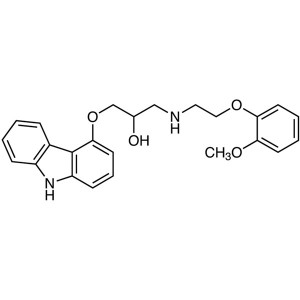
Carvedilol CAS 72956-09-3 Purity >99.0% (HPLC)
-
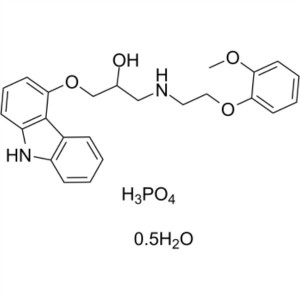
Carvedilol Phosphate Hemihydrate CAS 610309-89-...
-
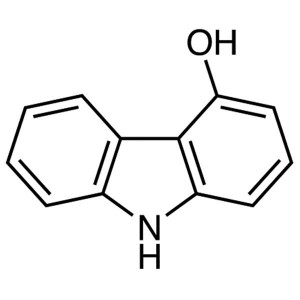
4-Hydroxycarbazole CAS 52602-39-8 Carvedilol In...
-
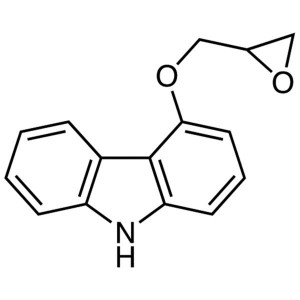
4-(2,3-Epoxypropoxy)carbazole CAS 51997-51-4 Ca...
-
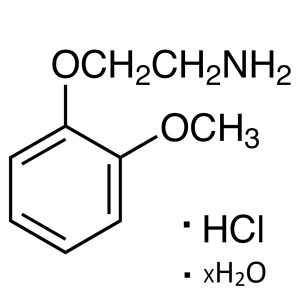
2-(2-Methoxyphenoxy)ethylamine Hydrochloride Hy...
-
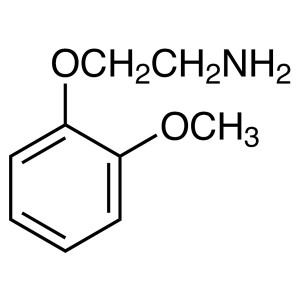
2-(2-Methoxyphenoxy)ethylamine CAS 1836-62-0 Ca...
-
![N-[2-(2-Methoxyphenoxy)ethyl]benzylamine HCl CAS 3246-03-5 Carvedilol Intermediate Purity ≥98.0% (HPLC)](https://www.ruifuchem.com/uploads/CAS-3246-03-5-Factory-Shanghai-Ruifu-Chemical-Co.-Ltd.-www.ruifuchem.com_-300x300.png)
N-[2-(2-Methoxyphenoxy)ethyl]benzylamine HCl CA...
-
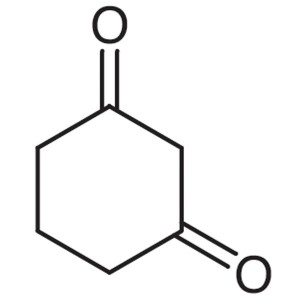
1,3-Cyclohexanedione CAS 504-02-9 Purity >99.0%...
-
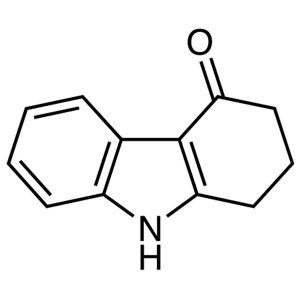
1,2,3,4-Tetrahydrocarbazol-4-one CAS 15128-52-6...

